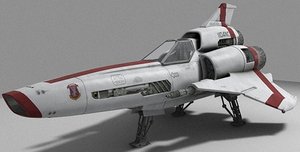Viper (TRS): Difference between revisions
More actions
Ernestborg9 (talk | contribs) mNo edit summary |
Ernestborg9 (talk | contribs) No edit summary |
||
| Line 1: | Line 1: | ||
==[[ | ==[[Battlestar Galactica (RDM)|Re-imagined Viper]]== | ||
=== Overview === | === Overview === | ||
Revision as of 21:02, 29 January 2005
Overview

The Viper is the Colonial Defence Force's primary space superiority fighter / attack craft. Capable of atmospheric flight, the Viper is a single-seat craft mounting two kinetic energy weapons (KEWs), as well as having hardpoints beneath the wings for mounting missiles, munitions pods and other ordnance (The Hand of God).
The Viper was originally introduced into Colonial service shortly before the outbreak of the Cylon War. However, it was the Mark II variant, designed specifically for use with the new Colonial Battlestars that is best remembered.
The Mark II served with distinction throughout the Cylon War, proving a capable fighting vehicle that won renown across the 12 colonies and is regarded as one of the reasons the Colonials did not suffer defeat at the hands of the Cylons.
The Mark II remained in service after the end of the war, but was subsequently superceded by newer models. At the time of the renewed Cylon attack on the 12 Colonies, the Mark VII was the front-line variant of the Viper design, incorporating an improved twin-engine layout and fully integrated combat control systems providing superior battle management and fight information for the pilot.
Ironically, it was the incorporation of the new integrated systems that prevented the majority of Mark VIIs from being effective during the Cylon attack: as with the majority of Colonial systems, the Mark VII suffered fatal computer glitches on contact with Cylon forces (Mini-Series). While the problem could be overcome by disabling the combat management systems in the Mark VII, this information was not discovered in time to be of major benefit to the surprised and hard-pressed Colonial forces.
Atmospheric Operations
The Viper is designed for atmospheric as well as space-based operations. However, Vipers consume more fuel during atmospheric operations than in the vacuum of space: once in an atmosphere, the engines must run continuously to retain airflow over the wing lifting surfaces. Depending on the composition of the atmosphere itself, this can place severe strain on the Viper's engines (You Can't Go Home Again).
Due to their wing configuration, Vipers may also suffer from poor handling at low speeds within an atmosphere.
Life Support
Viper cockpits are pressurised and heated, but they are flown with the pilot wearing a flight suit that is capable of providing full life support should ejection be required (You Can't Go Home Again). The life support systems are built-in to the back of the pilot's seat itself, together with the flight harness. Following an ejection, the back of the seat separates automatically, effectively becoming a backpack for the pilot (Act of Contrition).
Should ejection take place within an atmosphere, the life support backpack / seat back also incorporates a parachute.
Technical Specifications
Dimensions
Mark II
- Length: (approx) 25ft
- Wingspan: (approx) 14ft
Mark VII
- Length: (approx) 28ft
- Beam: (approx) 14ft
Propulsion
- 3x sublight engines mounted aft; 2x reverse thrust motors; RCS points
Aramaments
- Mark II: 2x forward-firing kenetic energy weapons (KEW) mounted in the wing roots
- Mark VII: 3x forward-firing kenetic energy weapons (KEW); 2 mounted towards the outboard sections of the wings; 1 mounted in the vertical stabiliser
- Both: Weapon hardpoints for mounting missiles / munitions pods, etc. under the wings
Crew
- Pilot
Notes
Layout
The Viper is a long, sleek vehicle that can be spilt into two parts, fore and aft.
- Fore section: comprises the nose back to the cockpit. This contains the forward RCS systems for manoeuvring the craft; the forward landing gear; the main avionics and sensor packages, plus the single-seat cockpit itself
- Stern section: comprises the main engines, fuel tanks, wings and vertial stabiliser. The wings themselves contain the kinetic energy weapons ("guns") and their munitions storage and feeds. Harpoints beneath the wings allow missiles, munitions pods and other items to be rack-mounted (The Hand of God). The wings roots contain the main landing gear. This section of a Viper also contains a number of RCS manoeuvring packs.
The stern section of a Viper is distinctive because of the offset "intakes" mounted just behind the cockpit. The port / starboard "intake" nacelles incorporate small but powerful reverse thrust engines that can quickly counter a Viper's forward momentum in an emergency (The Hand of God).
This section requires information
--Colonial Archivist 21:41, 8 Jan 2005 (EST)
